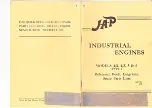
3.1
Section 3
Troubleshooting
3
Section 3
Troubleshooting
CV11-16
CV460-465, CV490-495
Troubleshooting Guide
When troubles occur, be sure to check the simple
causes which, at first, may seem too obvious to be
considered. For example, a starting problem could be
caused by an empty fuel tank.
Some common causes of engine troubles are listed
below. Use these to locate the causing factors.
Engine Cranks But Will Not Start
1. Empty fuel tank.
2. Fuel shut-off valve closed.
3. Dirt or water in the fuel system.
4. Clogged fuel line.
5. Spark plug lead disconnected.
6. Key switch or kill switch in ‘‘off’’ position.
7. Faulty spark plug.
8. Faulty ignition module.
Engine Starts But Does Not Keep Running
1. Restricted fuel tank cap vent.
2. Dirt or water in the fuel system.
3. Faulty choke or throttle controls.
4. Loose wires or connections that short the kill
terminal of ignition module to ground.
5. Faulty carburetor.
6. Faulty cylinder head gasket.
Engine Starts Hard
1. PTO drive is engaged.
2. Dirt or water in the fuel system.
3. Clogged fuel line.
4. Loose or faulty wires or connections.
5. Faulty choke or throttle controls.
6. Faulty spark plug.
7. Low compression.
8. Faulty ACR mechanism.
Engine Will Not Crank
1. PTO drive is engaged.
2. Battery (if equipped) is discharged.
3. Safety interlock switch is engaged.
4. Loose or faulty wires or connections.
5. Faulty key switch or ignition switch.
6. Faulty electric starter (if equipped).
7. Retractable starter not engaging in drive cup.
8. Seized internal engine components.
Engine Runs But Misses
1. Dirt or water in the fuel system.
2. Spark plug lead disconnected.
3. Loose wires or connections that intermittently
short the kill terminal of ignition module to ground.
4. Engine overheated.
5. Faulty ignition module.
Engine Will Not Idle
1. Restricted fuel tank cap vent.
2. Dirt or water in the fuel system.
3. Faulty spark plug.
4. Idle fuel adjusting needle improperly set.
5. Idle speed adjusting screw improperly set.
6. Low compression.
7. Stale fuel and/or gum in carburetor.
Engine Overheats
1. Air intake/grass screen, cooling fins, or cooling
shrouds clogged.
2. Excessive engine load.
3. Low crankcase oil level.
4. High crankcase oil level.
5. Faulty carburetor.
Engine Knocks
1. Excessive engine load.
2. Low crankcase oil level.
3. Old/improper fuel.
4. Internal wear or damage.
Summary of Contents for COMMAND CV11
Page 1: ...1 COMMAND SERVICE MANUAL VERTICAL CRANKSHAFT CV11 16 CV460 465 CV490 495...
Page 20: ...2 4 Section 2 Special Tools...
Page 28: ...4 4 Section 4 Air Cleaner and Air Intake System...
Page 54: ...6 6 Section 6 Lubrication System...
Page 109: ...9 15 Section 9 Disassembly 9 Regulating Pin Governor Gear Figure 9 53 Removing Governor Gear...
Page 110: ...9 16 Section 9 Disassembly...
Page 146: ...1 COMMAND SERVICE MANUAL VERTICAL CRANKSHAFT CV11 16 CV460 465 CV490 495...
Page 148: ......
















































